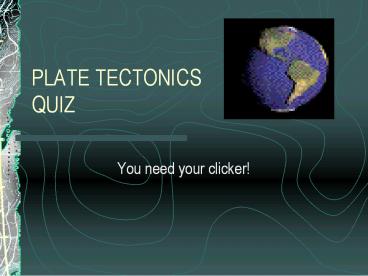PLATE TECTONICS QUIZ - PowerPoint PPT Presentation
Title:
PLATE TECTONICS QUIZ
Description:
Title: PLATE TECTONICS Author: Harmon Farms Last modified by: Weiper, Christina N Created Date: 11/2/2005 11:42:00 PM Document presentation format – PowerPoint PPT presentation
Number of Views:107
Avg rating:3.0/5.0
Title: PLATE TECTONICS QUIZ
1
PLATE TECTONICS QUIZ
- You need your clicker!
2
Review clip(click on the link above)
3
Review
- Divergent Boundary between two plates that are
moving apart. - Convergent Boundary between two plates that are
pushing together. - Transform (Strike-slip) Boundary between two
plates that are sliding past one another.
Causes Earthquakes - Subduction Zone The area where one plate pushes
down under another. Volcanoes are often created
by this.
4
1. As two continental plates move toward each
other, what landforms would you expect to see?
- Volcanoes
- Cliffs
- New Land
- Mountains
5
1. As two continental plates move toward each
other, what landforms would you expect to see?
- Volcanoes
- Incorrect
- These form at edges of plates or over hot spots
6
1. As two continental plates move toward each
other, what landforms would you expect to see?
- Cliffs
- Incorrect
- These are erosional landforms or minor uplift
areas
7
1. As two continental plates move toward each
other, what landforms would you expect to see?
- New Land
- Incorrect
- Forms when plates move apart
8
1. As two continental plates move toward each
other, what landforms would you expect to see?
- Mountains correct -
- because 2 continental masses will push into each
other and crumple the edges to form mountains
9
2. Where would you find the newest land on Earth?
- In areas of continental convergence
- In areas where two ocean plates come together
- In areas where plates are moving apart
- In areas where two plates are sliding past each
other
10
2. Where would you find the newest land on Earth?
- In areas of continental convergence
- Incorrect
- Mountains would form here from existing land.
11
2. Where would you find the newest land on Earth?
- In areas where two ocean plates come together
- Incorrect
- You would find trenches in this area.
12
2. Where would you find the newest land on Earth?
- In areas where two plates are sliding past each
other - Incorrect
- You would find land movement but not new land
being formed
13
2. Where would you find the newest land on Earth?
- In areas where plates are moving apart
- Correct
- When plates move apart it is due to magma
reaching the surface. When magma cools new land
is formed.
14
3. Texas is located on which tectonic plate?
- a. Indian
- b. Pacific
- c. South American
- d. North American
15
3. Texas is located on which tectonic plate?
- a. Indian
- b. Pacific
- c. South American
- d. North American
16
4. What will happen if tectonic plates shift?
- a. A volcano will erupt.
- b. A landslide will occur.
- c. An earthquake will happen.
- d. A hole will form in Earths surface.
17
4. What will happen if tectonic plates shift?
- a. A volcano will erupt.
- b. A landslide will occur.
- c. An earthquake will happen.
- d. A hole will form in Earths surface.
18
5. Earthquakes are more common in California than
they are in Texas because of the movement of
which two tectonic plates?
- a. South American and North American
- b. Pacific and South American
- c. Eurasian and African
- d. North American and Pacific
19
5. Earthquakes are more common in California than
they are in Texas because of the movement of
which two tectonic plates?
- a. South American and North American
- b. Pacific and South American
- c. Eurasian and African
- d. North American and Pacific































